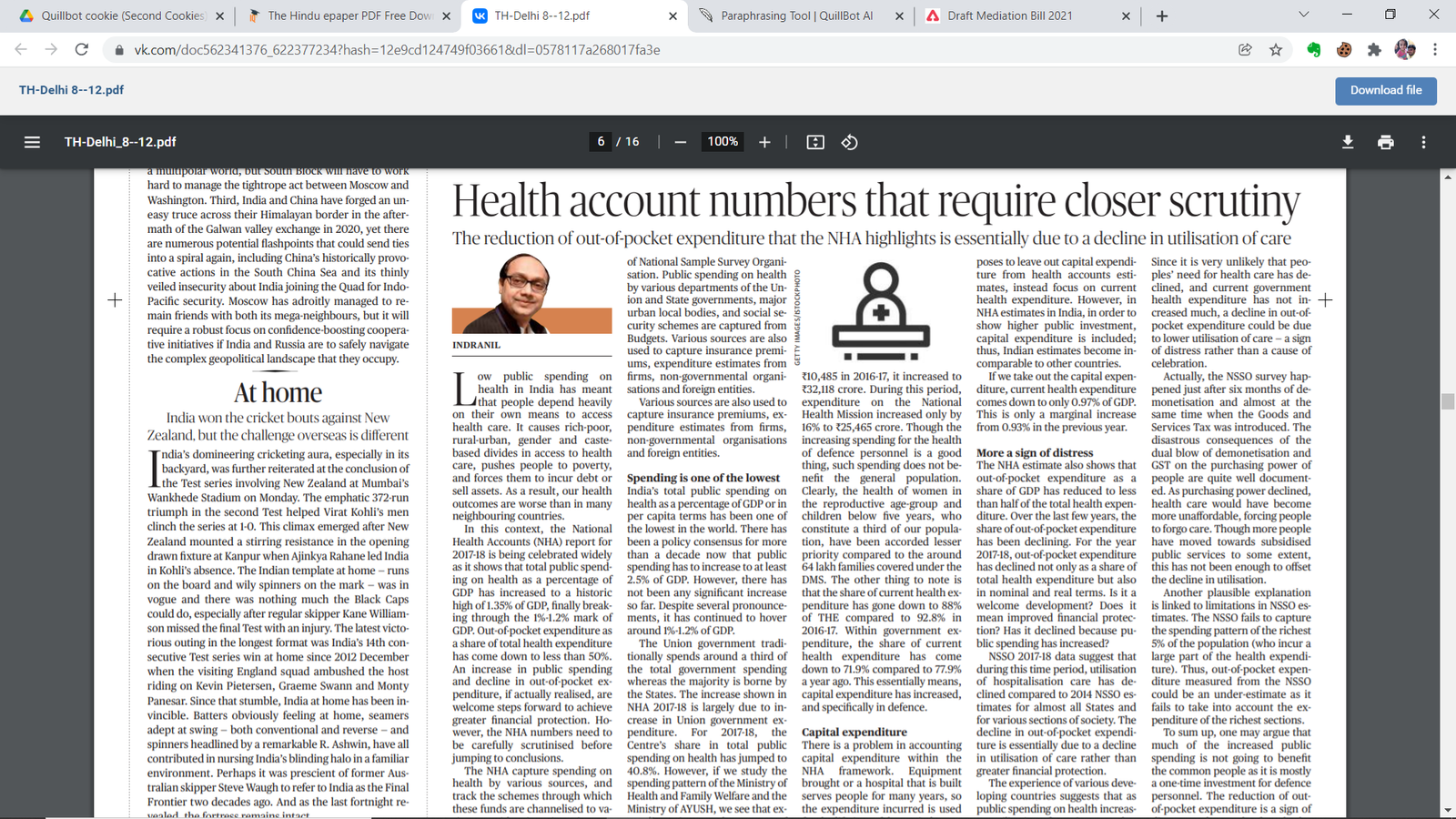
Prepare IAS Coaching
Current Affairs

Title : HEALTH ACCOUNT NUMBERS THAT REQUIRE CLOSER SCRUTINY
Date : Dec 09, 2021
Description :
HEALTH ACCOUNT NUMBERS THAT REQUIRE CLOSER SCRUTINY:
Based on a News Article published in the ‘The Hindu’ on 08th December 2021 on Page Number 6
Useful for UPSC CSE Prelims and Mains (GS Paper III)
World Bank data on the state of India's health infrastructure:
- In 2017, India had 85.7 physicians per 100,000 people (in contrast to 98 in Pakistan, 100 in Sri Lanka and 241 in Japan).
- There are 53 beds for every 100,000 persons (in contrast to 63 in Pakistan, 79.5 in Bangladesh, 415 in Sri Lanka and 1,298 in Japan).
- There are 172.7 nurses and midwives for every 100,000 persons (in contrast to 220 in Sri Lanka, 40 in Bangladesh, 70 in Pakistan, and 1,220 in Japan).
- India has one of the largest out-of-pocket (OOP) expenses of any country in the world, accounting for 62 percent of total health spending.
The COVID-19 outbreak prompted an examination of India's healthcare system:
- Treatment and Viewing of the Healthcare System: The sad loss of life, the exponential growth in cases, the economic quagmire, and social upheavals have revealed a deeper subtext on how the healthcare industry is regarded and treated.
- The emergence of reports on the problem of healthcare: The epidemic has brought to light a long-standing issue of healthcare workers protesting equipment shortages, patients accusing doctors and hospitals of profiteering, policymakers issuing edicts against providers, and incidences of crucial pharmaceutical stockpiling.
- Stakeholders in the healthcare system are becoming increasingly disinterested: During the pandemic, the rising lack of trust between patients and their doctors and providers, as well as the wider mistrust between policymakers and the industry, gained new momentum.
Healthcare in India is on the verge of a digital transformation:
- In terms of revenue and employment, healthcare has become one of India's most important industries.
- Hospitals, medical devices, clinical trials, outsourcing, telemedicine, medical tourism, health insurance, and medical equipment are all part of the healthcare industry.
- The Indian healthcare system is expanding rapidly as a result of improved coverage, services, and increased spending by both public and private entities.
- The public and private sectors of India's healthcare delivery system are divided into two categories.
- The government, or public healthcare system, has a limited number of secondary and tertiary care institutions in major cities and focuses on delivering basic healthcare in rural regions through primary healthcare centres (PHCs).
- The bulk of secondary, tertiary, and quaternary care facilities are run by the private sector, with a concentration in metros and tier I and tier II cities.
- The enormous pool of well-trained medical personnel in India is India's competitive advantage. In comparison to its Asian and Western counterparts, India is also cost competitive.
- Surgery in India costs around a tenth of what it costs in the United States or Western Europe. In terms of healthcare quality and accessibility, India ranks 145th out of 195 countries.
The following are the reasons and causes for this:
- Public health spending is low, at 1% of GDP in 2013-14 and 1.28 percent in 2017-18. (including expenditure by the Centre, all States and Union Territories).
- Because the main bodies with technical expertise are under central authority, the centre is a key participant in public health management.
- The National Centre for Disease Control and the Indian Council of Medical Research are two examples of expert bodies that do not exist in the states.
- Because of the huge range in per capita health expenditure, states also differ greatly in terms of fiscal space to deal with the emerging coronavirus pandemic.
Variation in per capita health-care spending across states (from 2010-11 to 2019-20):
- Kerala and Delhi have consistently ranked around the top over the years.
- In every year, Bihar, Jharkhand, and Uttar Pradesh have been around the bottom of the rankings.
- Odisha is notable because, in 2010, it had the same per capita health expenditure as Uttar Pradesh, but today has more than doubled it.
The following measures are required to improve the country's current status of health infrastructure:
- Despite being lower than the global average of 5.4 percent, there is an immediate need to increase public spending to 2.5 percent of GDP.
- The success of a stress-free and complete wellness system for everyone is dependent on the effectiveness of health and wellness centres, since they will be critical in decreasing the higher burden of out-of-pocket health spending.
- Over the next decade, there is a need to break free from the existing trend of inconsistent and insufficient growth in health spending and make significant and persistent investments in public health.
- A National Health Regulatory and Development Framework is needed to improve healthcare delivery quality (for example, registration of health practitioners), performance, equity, efficacy, and accountability across the country.
- Increase the number of public-private partnerships to expand healthcare's last-mile reach.
- To make medicines more economical and lower the major component of Out of Pocket Expenditure, the number of generic drugs and Jan Aushadi Kendras should be raised.
- The government's National Innovation Council, which is charged with facilitating collaboration among healthcare domain experts, stakeholders, and key participants, should promote an innovation culture in India and assist in the development of policy on innovations that are based on an Indian model for inclusive growth.
- India should follow the lead of other developing countries such as Thailand in pursuing Universal Health Coverage. Population coverage, disease coverage, and cost coverage are the three components of UHC.
- Using information technology to improve the quality of healthcare service delivery, such as computer and mobile phone-based e-health and m-health programmes. From process automation to diagnostics to low-cost technologies, start-ups are investing in the healthcare sector. To make healthcare more accessible and cheap, policy and regulatory support should be offered.
Regulation of the Private Sector:
- Another evident priority that has been emphasised throughout the Covid-19 outbreak is the necessity to regulate private sector fees and standards of care.
- Even among the middle class, massive hospital expenditures have caused a great deal of anguish.
- Although a number of factors have led to the Mucormycosis pandemic, it appears that inappropriate use of steroids in Covid-19 patients, particularly diabetics, has been a major role.
- The federal government should take the required efforts to ensure that the Clinical Establishments (Registration and Regulation) Act is fully implemented (CEA).
- This Act, which was passed in 2010 and now applies to 11 states across India, has not been fully implemented due to a significant delay in the notification of central minimum criteria and a failure to build a central framework for rate control.
Prescriptions of the NITI Aayog:
- The document 'Investment Opportunities in India's Healthcare Sector' was just issued by the NITI Aayog.
- 'In the hospital market, the growth of private players to Tier 2 and Tier 3 areas outside of metropolitan centres presents an appealing investment opportunity,' according to the study.
- Medical device and equipment manufacturing, diagnostic and pathology centre expansion, and miniaturised diagnostics all have great growth potential.
- Artificial intelligence, wearables, and other mobile technology, as well as the Internet of Things, provide a plethora of investment opportunities.
Conclusion:
- To address difficulties in the healthcare industry in India, a holistic strategy is required.
- This entails active collaboration among all stakeholders, including the governmental, private, and individual sectors.
- To deal with the dual disease load, a more dynamic and proactive approach is required.
- Universal health care keeps the country fit and healthy, making it easier to obtain the demographic dividend.
